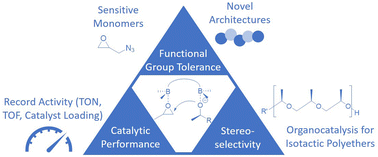Borane catalysis for epoxide (co)polymerization
Abstract
Since 2016, when simple triethylborane (Et3B) was revealed as a very capable catalyst for the copolymerization of epoxides and carbon dioxide, research effort regarding this type of organic Lewis acid has soared. This interest is well-founded and connected to some striking features of Et3B-based polymerization catalysis. Especially for the homo- and copolymerization of epoxides, this has enabled a step change in functional group tolerance and polymerization control, also including beneficial practical aspects such as rapid monomer consumption, fully metal-free setups and very low catalyst loadings. As a result, polyethers, polyether-containing complex architectures and various epoxide-based copolymers can now be addressed with unprecedented precision, in turn unlocking extended or even novel applications for these polymers. This review intends to highlight the advances made in the past few years, focusing on the catalytic performance of Et3B and emerging strategies for (multi)borane catalyst design, alongside mechanistic considerations and how these are reflected in the respective polymers. Thereby, it is hoped to raise awareness for borane catalysis as a disruptive tool with significant technological potential for polyether chemistry and related fields.

- This article is part of the themed collection: Polymer Chemistry's Most Popular 2023 Articles


 Please wait while we load your content...
Please wait while we load your content...